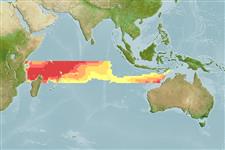Actinopterigi (pesci con pinne raggiate) >
Myctophiformes (Lanternfishes) >
Myctophidae (Lanternfishes) > Lampanyctinae
Etymology: Diaphus: Greek, dis, dia = through + Greek, physa, phyo = to beget, to have as offspring (Ref. 45335).
Ambiente / Clima / Range
Ecologia
; marino batipelagico; oceanodromo (Ref. 51243); distribuzione batimetrica ? - 500 m (Ref. 4066). Deep-water, preferred ?; 4°S - 17°S
Western Indian Ocean: 04°-12°S, 40°-65°E. Eastern Indian Ocean: 17°02'S, 94°50'E.
Size / Peso / Age
Maturity: Lm ? range ? - ? cm
Max length : 5.5 cm SL maschio/sesso non determinato; (Ref. 4066)
Spine dorsali (totale): 0; Raggi dorsali molli (totale): 14-15; Spine anali 0; Raggi anali molli: 15 - 17
Oceanic and mesopelagic, found in the upper 500 m at night.
Life cycle and mating behavior
Maturità | Riproduzione | Deposizione | Uova | Fecundity | Larve
Hulley, P.A., 1986. Myctophidae. p. 282-321. In M.M. Smith and P.C. Heemstra (eds.) Smiths' sea fishes. Springer-Verlag, Berlin. (Ref. 4066)
IUCN Red List Status (Ref. 115185)
CITES (Ref. 94142)
Not Evaluated
Threat to humans
Harmless
Human uses
Informazioni ulteriori
Nomi ComuniSinonimiMetabolismoPredatoriEcotossicologiaRiproduzioneMaturitàDeposizioneFecundityUovaEgg development
Age/SizeAccrescimentoLength-weightLength-lengthLength-frequenciesMorfometriaMorfologiaLarveDinamica popolazioni larvaliReclutamentoAbbondanza
BibliografiaAcquacolturaProfilo di acquacolturaVarietàGeneticaFrequenze allelicheEreditarietàMalattieElaborazioneMass conversion
CollaboratoriImmaginiStamps, CoinsSuoniCiguateraVelocitàModalità di nuotoArea branchialeOtolithsCervelliVista
Strumenti
Special reports
Download XML
Fonti Internet
